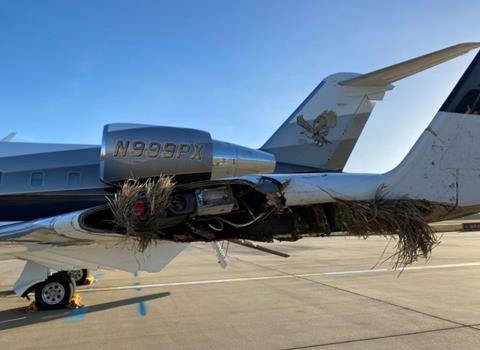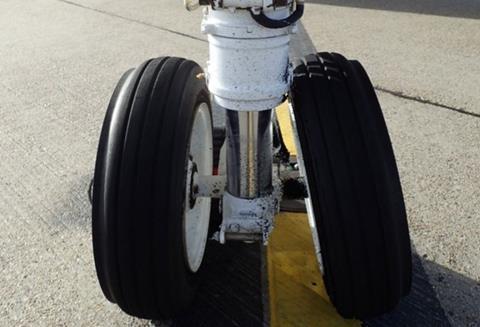UK investigators believe a Bombardier Challenger 604 crew’s approach to London Stansted was too slow for the crosswind conditions, causing it to land hard – nose-gear first – and strike the ground several times with its wing.
The wing remained in contact with the ground and the jet experienced a runway excursion into the grass before the crew executed a go-around and diverted to London Gatwick.
Inspection of the jet (N999PX) found that its wing structure was excessively damaged and the aircraft was declared a write-off.

Analysis of the accident found the crew of the flight, which was arriving in darkness from Hurghada on 31 January last year, had calculated a reference speed of 119kt and an approach speed of 125kt.
But the UK Air Accidents Investigation Branch determined that the reference speed should have been 4kt higher and that the approach speed, for the winds reported, should have been 17kt higher.
“The lower speed used by the crew provided less margin for the effects of a gusting wind, with the potential for an excessive [angle-of-attack] to develop,” says the inquiry.
As the Challenger neared touchdown on runway 22 the crew allowed its speed to dip below 125kt without applying engine thrust to compensate.
This premature deceleration resulted in the jet’s having reduced energy as it entered the flare, indicating that the pilots were not closely monitoring the airspeed.
The aircraft floated above the runway at about 10ft for 6s, possibly because the captain wanted to ensure a smooth landing for the passengers.
But the jet yawed and rolled rapidly in the gusting conditions and the stick-shaker activated, almost immediately followed by the stick-pusher, and the aircraft touched down on its nose-wheel before the left- and right-hand main landing-gear successively made contact.

Inspection of the runway showed three separate wing-strike marks, each about 20m long, and left wing-tip contact with the ground continued as the jet veered into the adjacent grass. The wing-tip struck a concrete pad as the jet travelled through the rough ground.
The crew initiated a go-around and the captain pitched the aircraft up as it accelerated through the approach reference speed. According to the first officer, the jet pitched up “excessively” to around 20-25° and – with the airspeed declining to 180kt – he pushed on the controls and told the captain to fly level and maintain speed at 200kt.
Stansted air traffic controllers had seen sparks from the aircraft as it touched down, and inquired over the crew’s situation. The crew initially requested vectors for another ILS approach but then considered the possibility of nose-wheel damage, and sought an alternative airport with better wind conditions – eventually diverting to land safely at Gatwick.
Neither the two pilots nor the two passengers was injured, but the aircraft suffered substantial damage to its nose-wheel and left wing.
Alignment checks found a permanent deformation of the wing attachment point, meaning its ultimate strength had been exceeded, and the jet would require an entire wing replacement to return to service, and insurers decided that the aircraft was beyond economical repair.


























